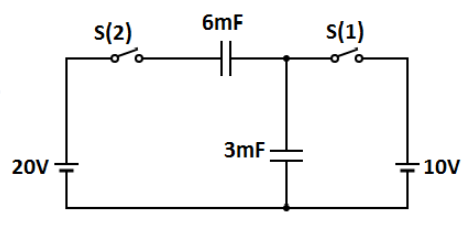
Answer
377.1k+ views
Hint: In order to find the charge stored on capacitor of capacitance $6\mu F$ we will find the magnitude of difference of potentials between two ends of the capacitor of capacitance $6\mu F$ and then by using the relation between charge, potential difference and capacitance of a capacitor we will find the charge using $Q = CV$ .
Complete step by step answer:
Given that, As soon as switch ${S_1}$ is closed then the battery of $10V$ starts to supply current in second half of circuit and no current will pass through the $6\mu F$ side section of circuit and thus the right side of $6\mu F$ capacitor will have a negative potential of $10V$ .
Secondly, when switch ${S_2}$ is being closed at that moment no current flows in second half circuit due to steady state and hence potential on right side of capacitor $6\mu F$ remains same which is $10V$ and due to the second battery of voltage $20V$ the left side of $6\mu F$ will have a potential of positive $20\,V$.Hence, net potential difference across the capacitor of $C = 6\mu F$ will be $(20 - 10)V$ which is
$C = 6\mu F$
$\Rightarrow \text{Voltage} = 10\,V$
Using $Q = CV$ we get,
$Q = 6 \times 10$
$\therefore Q = 60\mu C$
Hence, the charge on the capacitor of capacitance $6\mu F$ is $Q = 60\mu C$.
Note:Remember that, as the steady state of a capacitor is reached no more current flows across the capacitor and their potentials remain the same. The micro coulomb is the unit of charge which is related as $1\mu C = {10^{ - 6}}C$ and similarly $1\mu F = {10^{ - 6}}F$ which is a unit of capacitance.
Complete step by step answer:
Given that, As soon as switch ${S_1}$ is closed then the battery of $10V$ starts to supply current in second half of circuit and no current will pass through the $6\mu F$ side section of circuit and thus the right side of $6\mu F$ capacitor will have a negative potential of $10V$ .
Secondly, when switch ${S_2}$ is being closed at that moment no current flows in second half circuit due to steady state and hence potential on right side of capacitor $6\mu F$ remains same which is $10V$ and due to the second battery of voltage $20V$ the left side of $6\mu F$ will have a potential of positive $20\,V$.Hence, net potential difference across the capacitor of $C = 6\mu F$ will be $(20 - 10)V$ which is
$C = 6\mu F$
$\Rightarrow \text{Voltage} = 10\,V$
Using $Q = CV$ we get,
$Q = 6 \times 10$
$\therefore Q = 60\mu C$
Hence, the charge on the capacitor of capacitance $6\mu F$ is $Q = 60\mu C$.
Note:Remember that, as the steady state of a capacitor is reached no more current flows across the capacitor and their potentials remain the same. The micro coulomb is the unit of charge which is related as $1\mu C = {10^{ - 6}}C$ and similarly $1\mu F = {10^{ - 6}}F$ which is a unit of capacitance.
Recently Updated Pages
How many sigma and pi bonds are present in HCequiv class 11 chemistry CBSE

Mark and label the given geoinformation on the outline class 11 social science CBSE

When people say No pun intended what does that mea class 8 english CBSE

Name the states which share their boundary with Indias class 9 social science CBSE

Give an account of the Northern Plains of India class 9 social science CBSE

Change the following sentences into negative and interrogative class 10 english CBSE

Trending doubts
Fill the blanks with the suitable prepositions 1 The class 9 english CBSE

The Equation xxx + 2 is Satisfied when x is Equal to Class 10 Maths

In Indian rupees 1 trillion is equal to how many c class 8 maths CBSE

Which are the Top 10 Largest Countries of the World?

How do you graph the function fx 4x class 9 maths CBSE

Give 10 examples for herbs , shrubs , climbers , creepers

Difference Between Plant Cell and Animal Cell

Difference between Prokaryotic cell and Eukaryotic class 11 biology CBSE

Why is there a time difference of about 5 hours between class 10 social science CBSE




